Vice ADM Rowden: Scapegoat?
Posted on
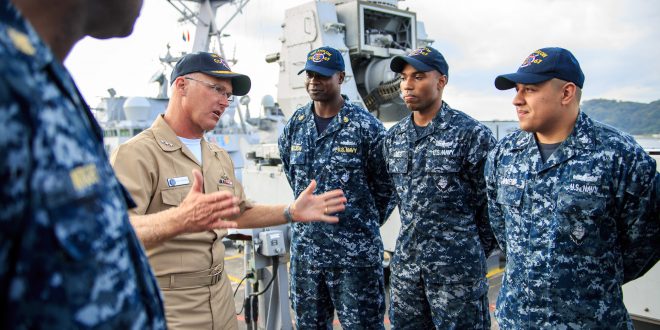
Vice Adm. Thomas Rowden speaks to sailors aboard USS Shoup
WASHINGTON: After a string of firings and retirements, the highest-ranking naval officer yet stepped down over accidents that killed 17 sailors. But was Vice Adm. Tom Rowden truly culpable in the summer 2017 collisions, or is he a scapegoat for deeper systemic problems? Our expert sources frankly disagreed.
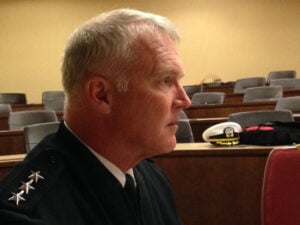
Vice Adm. Tom Rowden
The argument against Rowden is simple. As the Director of Surface Warfare in the Pentagon and then Commander of Naval Surface Forces in San Diego, he had to be aware of the stress the surface fleet was under as the number of ships shrank, budgets became erratic, and training and maintenance fell behind, even as the demand for overseas deployments continued. He didn’t fix the problem; he didn’t raise hell about it, at least not publicly; and he didn’t resign in protest. Therefore he’s as culpable as the captains of the two ships involved, the destroyers McCain and Fitzgerald, who will now face criminal charges. By comparison, Rowden, who just had to move up his retirement date, got off easy.
The counter-argument is that Rowden is being held responsible for things he couldn’t control. It’s ultimately up to the skipper of each ship to ensure the crew is trained and the ship is in good condition. And it’s ultimately up to Congress to provide the funding to train, maintain, and operate the force. The admirals in between are middle managers, struggling to meet all the missions assigned with only the resources provided. Sure, they could resign in protest or go public with the problems, but violating the chain of command this way goes against deeply ingrained military culture, where the ethos is to shut up, roll up your sleeves, and somehow make it work.
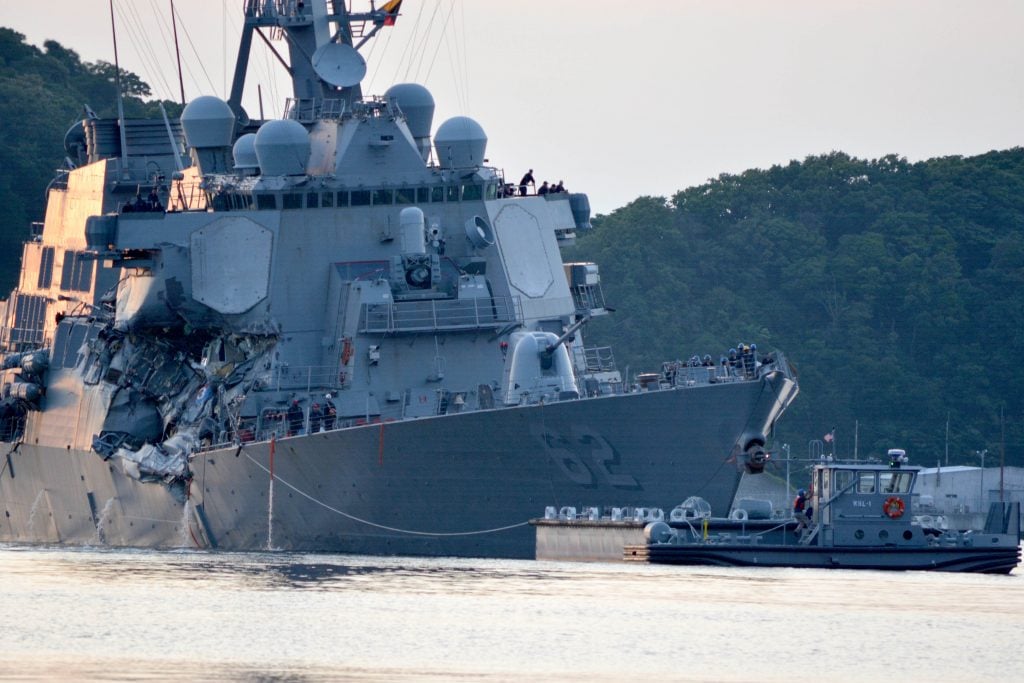
The damaged destroyer USS Fitzgerald pulls into Yokosuka, Japan after colliding with a commercial ship. Seven sailors died.
Rowden Wasn’t Responsible
“I believe Vice Adm. Rowden recognized the readiness challenges surface forces were facing, but like other surface force leaders, he was put in the situation of having to salute and carry on, because Navy HQ either agreed to continue deploying ships or were told by the Office of the Secretary of Defense to do so,” said Bryan Clark, a retired Navy commander now with the Center for Strategic & Budgetary Assessments. “Arguably, he could have done more to ‘die in the ditch’ over readiness, but I believe he made his concerns known.”
Rowden didn’t create this problem, agreed another retired commander, Bryan McGrath. “None of the officers disciplined thus far wrote or approved budgets or generated independent operational tasking,” McGrath told me. “Yet a lack of resources and too many commitments have both been identified as systemic contributions to the tragedies. The officers responsible for those decisions have come under little scrutiny.”
Conversely, lower levels — up to and including Rowden — have been punished too indiscriminately, McGrath argued. “I’m concerned that the punishment of what is most of the Forward Deployed Naval Forces – Japan chain of command has done damage to the Navy’s unique and defining view of the inseparability of responsibility, authority, and accountability in command,” he said. “Before the investigation into the cause of the first collision (Fitzgerald) had even started, much of the naval intelligentsia abandoned the Navy’s time-honored notion of fixing ultimate responsibility with the commanding officer, in favor of a view that seemed to suggest that responsibility for these accidents should be shared with those in charge of the system that supported the ships.”
“Once this die was cast, firings and retirements up the chain of command were inevitable,” McGrath continued. “Yet an interesting question has now been raised, and that is, where does this sharing of responsibility end? What is the limiting principle?”
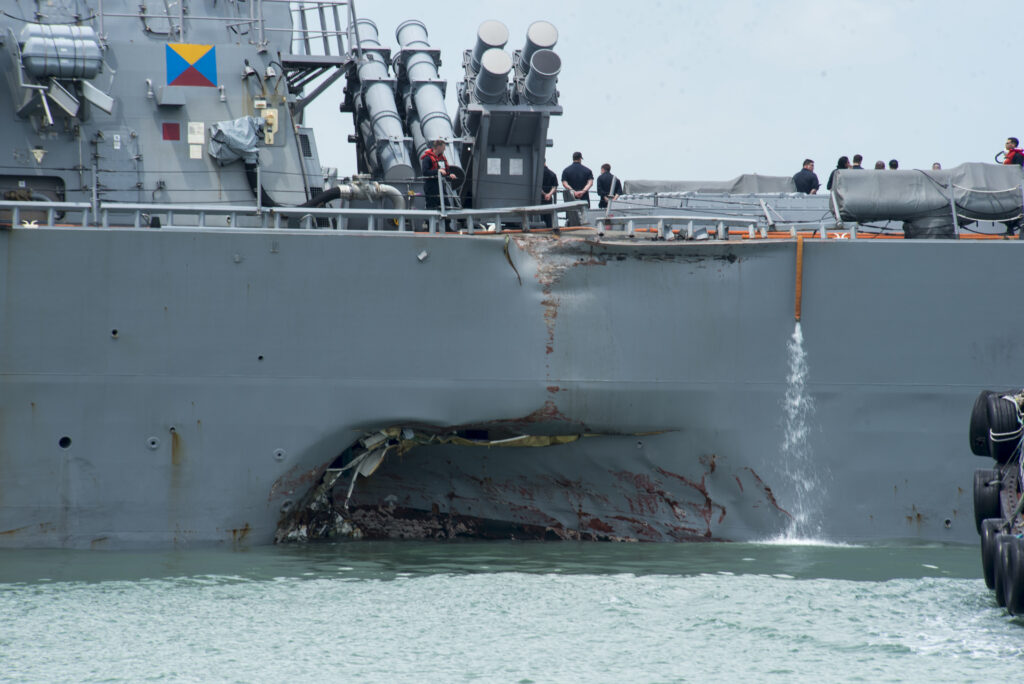
The USS McCain heads for Shanghai after a collision that killed 10 sailors.
Rowden Had To Go
Another retired naval officer, however, though Rowden was treated justly. “I like the guy but he made some terrible strategic mistakes,” said the officer, who asked to remain anonymous. As the fleet shrank and stress increased, “we should have cried uncle and told the politicians that the Navy was broken,” the retired officer said, but Rowden didn’t do that. Instead the admiral kept trying to do more with less. Even his signature Distributed Lethality concept was arguably a way to get more firepower out of a shrinking fleet.
“I think he was doing what he thought best, and I know he loves the Navy,” the retired officer told me, “but in the end, he set the surface community and the Navy writ large up for failure. He should have been gone a while ago.”
Clark agrees Rowden had to go, but not as punishment: Instead, the surface force needs a new style of leadership, one which routinely rejects assignments that will overstress the fleet. “I think this is a justified change, but not as a punitive measure,” Clark told me. “I believe this is a good change…because the surface force needs to turn the page and shift from being a demand-based force to being a supply-based force. It will have to focus on readiness and increasingly say no to deployments.”
“The submarine force has been taking this approach for decades,” said Clark, a former submariner himself, “and we now have a clear indication of what happens when the surface force does not control its output to align with its input. A supply-based model is very different than the traditional surface force philosophy and we will need a new leader in the job who can embrace that new approach.”
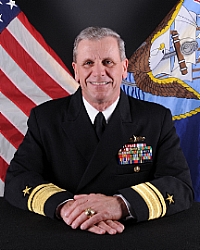
Rear Adm. Richard Brown
Though plans may change, Rowden’s likely successor is Rear Adm. Richard Brown, who’s currently deputy to the Chief of Naval Personnel. CNP manages the Navy’s most vital and over-stressed resource, its people. Brown “is a good choice,” Clark said, because “he will come in with a good understanding of the most complex part of the readiness challenge.”
Brown has served in surface warships throughout his career, commanding the destroyer The Sullivans, the cruiser Gettysburg, and Carrier Strike Group 11 (built around the Nimitz).
“I want to tell you that the surface force will be in good hands — as a matter of fact, great hands,” Rowden said of Brown in his swansong speech at the Surface Navy Association last week. “Rich is a friend, and he is a superb and talented naval officer. He succeeded wildly at sea, and he’s been a crucial part of the surface force leadership team for years now.”
Rowden was originally going to hand over command to Brown in a public ceremony Feb. 2. Now he’ll step down on the 18th, without fanfare.
“Today, I have informed the Chief of Naval Operations that this Thursday I will step aside earlier than previously planned,” Rowden said in a statement this afternoon. This was a difficult decision to make, but I make it with the best interest of the Surface Warfare community and the Navy in mind….. I’ve loved this job and the people I’ve worked with. It has been the highest honor to serve our Nation and the Navy for more than 40 years.”
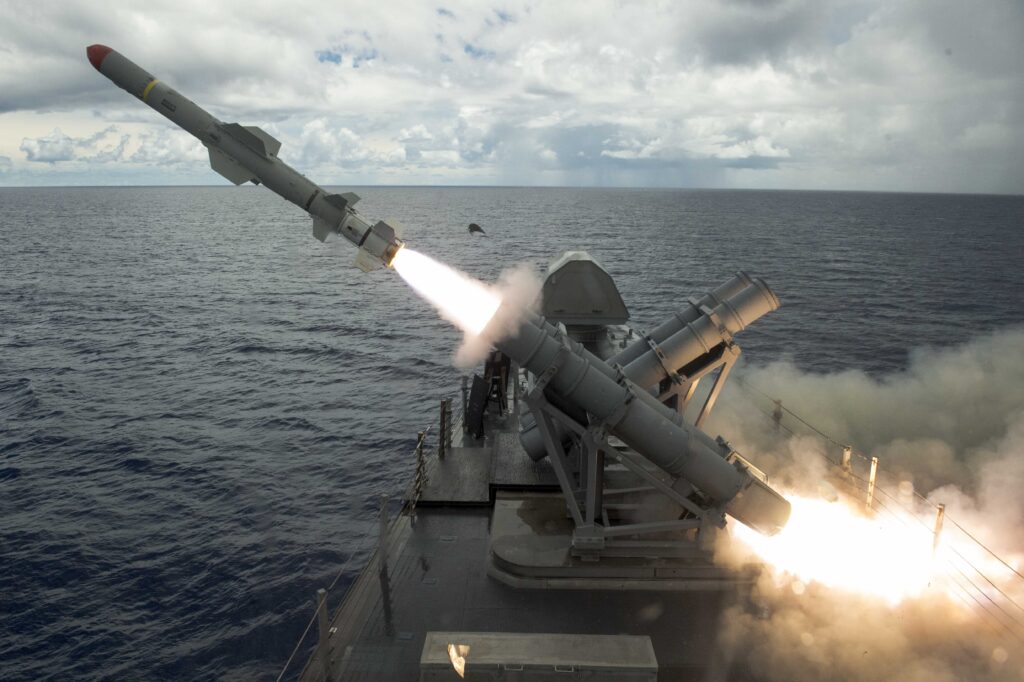
The Littoral Combat Ship USS Coronado launches a Harpoon anti-ship missile during a test off Guam.
Rowden’s Legacy
What will Rowden’s legacy be? Whatever his responsibility for the frayed state of the surface force in the present, he was an articulate and engaging advocate for its future. He pushed hard to reorient the fleet from presence patrols and counterterrorism to preparation for high-end warfare against nation-states such as Russia and China, what he called a warfighting “renaissance.” In particular, he helped push the surface fleet towards a concept called Distributed Lethality — “if it floats, it fights” — under which every warship and even some auxiliaries must be capable of sinking enemy vessels.
“I think distributed lethality, or at least the push for new offensive operational concepts, continues even after Vice Adm. Rowden leaves,” said Clark. “The surface fleet “got religion” on this point and is aggressively pursuing a variety of ways to improve the ability of ships to conduct anti-surface warfare and fight in the electromagnetic spectrum.”
“The challenge is they do not have a lot of money,” Clark continued, “so I wouldn’t be surprised if they move forward on Tomahawk anti-ship missile, SM-6, and the LCS surface-to-surface missile, but delay or stop the long-term OASUW (Offensive Anti-Surface Warfare) weapon.”
Rowden will be around to keep advocating for these systems and concepts: He may be out, but he’s not down. “This is my last symposium in uniform,” Rowden told the Surface Navy Association. “Next year — if I’m finished hiking the Appalachian Trail, which could be in question as I walk rather slow — I hope to be sitting up front here with the other retired SWO Flags (i.e. surface warfare officer admirals, including his own father); fully invested in the health and the future of the community—but with younger men and women responsible for overseeing all of this.”
Subscribe to our newsletter
Promotions, new products and sales. Directly to your inbox.
